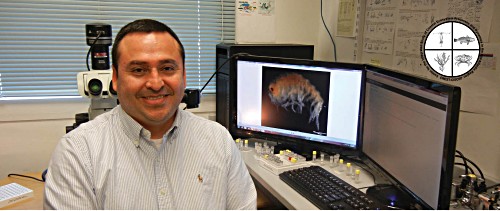Andrés G. Morales-Núñez, Ph.D., a postdoctoral research associate at the National Science Foundation CREST Center for the Integrated Study of Coastal Ecosystems and Processes (CISCEP) at the University of Maryland Eastern Shore (UMES), recently discovered a new species of amphipod in the Maryland Coastal Bays. The species was named Apolochus cresti, after the CREST-CISCEP center and the article, co-authored by Paulinus Chigbu, Ph.D., was published in ZooKeys.

Even the smallest of creatures have meaning in our coastal aquatic ecosystems. Amphipods, like the one discovered by UMES’ Andrés G. Morales-Núñez, are tiny crustaceans that range in size from less than an inch up to more than foot long and are found in almost all aquatic environments. Apolochus cresti measures in at less than an eighth of an inch.
According to Morales-Núñez, amphipods are important source of food for crabs, shrimp, fishes and birds and serve as bioindicators of water quality.
“They are numerically among the most important epifaunal invertebrates associated with macroalgae and sea grasses in estuaries and coastal lagoons, and their abundance, diversity, and sensitivity to pollution make them suitable as indicators of water quality conditions,” Morales-Núñez said.
The species lives in the often-overlooked Maryland Coastal Bays (MCBs), which is a barrier-island system. The system consists of five principal lagoons such as the Assawoman, Isle of Wight, Sinepuxent, Newport, and Chincoteague Bays.
The discovery of this species is an important reminder for the public that, “we need the small things to have the big things,” Morales-Núñez says. “If you want to go fishing in Ocean City, Md., you need to take care of the smaller invertebrates that feed the crabs and fish you want to catch.”
Relatively little is known about amphipods and benthic marine invertebrates in general, especially about the abundance, distribution and diversity of benthic marine macro-invertebrates in the Mid-Atlantic region. With this new information the government agencies may be able to create better plans to preserve the quality and health of our estuarine and coastal ecosystems.
Morales-Núñez collected the samples for this survey along the MCBs in 2012. At that time, the goal was to estimate and determine the abundance, distribution, and diversity of benthic marine macro-invertebrates associated with macroalgae in MCBs as part of the CREST – CISCEP project.
“I was pretty confident that this survey would give us the opportunity to find new species and new records of benthic marine macro-invertebrates to MCBs and the Mid-Atlantic region,” Morales-Núñez said.
And that’s what he did. This is the first species described by Morales-Núñez under the CREST-CISCEP program, but there is more to come. Morales-Núñez has identified two possible new species, another amphipod and a cumacean, which is a type of shrimp.
Because of their size, amphipods like Apolochus cresti, are difficult to identify.
“It was a challenge to identify and dissect this species because the specimens are small and fragile. You need a well-trained eye and tons of patience to get access to the mouthparts, which contains the most important features for separating different species within this genus,” Morales-Núñez shared.
As part of the research paper that came out of this discovery, Morales-Núñez created a key to help future researchers identify and separate the species of this genus.
When it came time to name the new species, Morales-Nunez decided to name it Apolochus cresti, after the National Science Foundation CREST program and the CREST-CISCEP Center at UMES.
“As the person who discovered the species you have the power to choose the name,” Morales-Nunez said. “For many people in this country, including me, the NSF CREST program has provided support for research, and our CREST-CISCEP center here has made significant contributions that have enhanced our understanding of the MCBs ecosystem.”
“I thought it would be a nice way to give recognition the program,” he continued.
Morales-Nunez joined the CREST-CISCEP center in August 2011 after completing his Ph.D. in Marine Sciences (Biological Oceanography) at the University of Puerto Rico, Mayaguez Campus. He earned a B.S. in Marine Biology from the University of Bogota Jorge Tadeo Lozano in Colombia in 2002 and a M.S in Biology from the University of Puerto Rico, Mayaguez Campus in 2006.
The article by Morales-Nunez is available in ZooKeys at http://dx.doi.org/10.3897/zookeys.571.7440.

